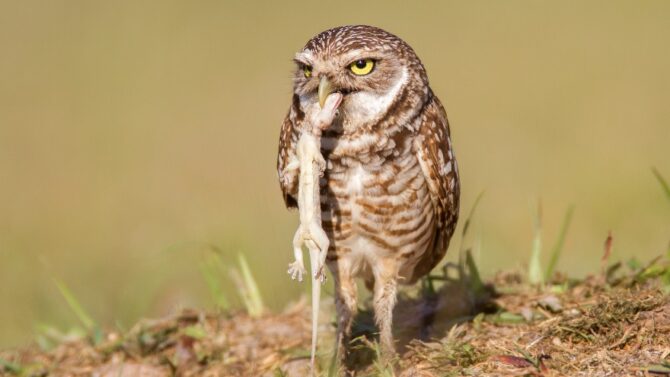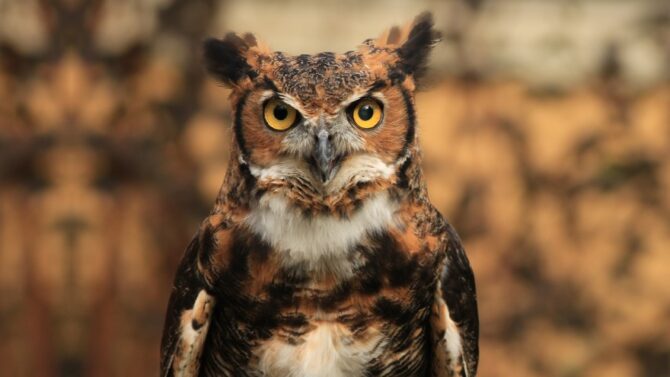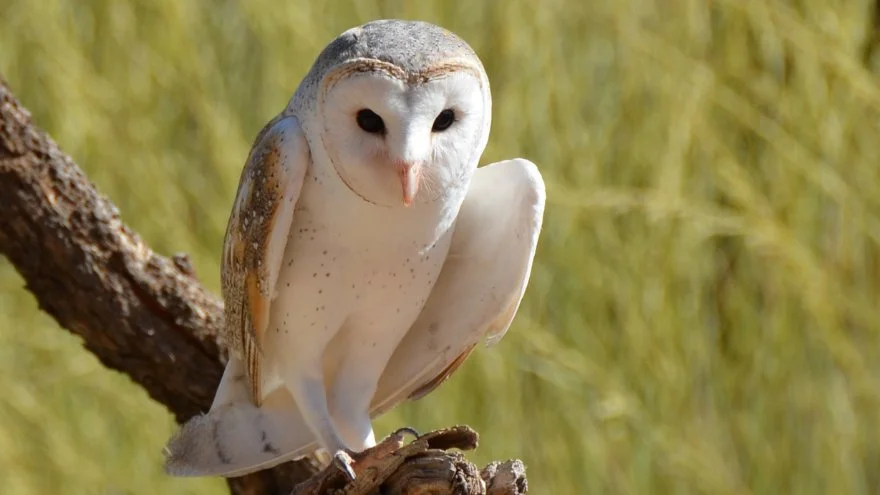Owls are fascinating nocturnal creatures that are known for their silent flight, exceptional hearing, and unique appearance.
These birds of prey have been the subject of myths and legends for centuries, and their mysterious nature gets our attention every time.
One of the most intriguing aspects of owls is their diet; hence, we will delve into the question, “What do owls eat in the wild?”
Owls are birds of prey, which makes them carnivores. Their diet is influenced by factors like species, environment, and climate.
Examples of its prey are smaller birds, mammals, and insects.
We will explore the various types of prey these birds hunt and consume, their hunting strategies, adaptations that make them efficient predators, and their place on the food chain.
Owl Diet: What Do Owls Eat?

All birds of prey are carnivores, including the enigmatic owl. As such, it feeds only on meat.
Different species have their needs, and the owl family has a role to play in the ecosystem as well.1
Climate and the specific habitat are other factors that influence what an owl feeds on.
In general, the owl’s diet revolves around insects, mammals, other birds, and fish.
If we want to get more specific, we need to look at each species to determine what they eat.
For example, the barn owl feeds on rodents, insects, rabbits, and birds. By contrast, the snowy owl eats lemmings, fish, and voles.
Big owls, like the eagle owl, can go after larger prey like foxes and ducks. Surprisingly, your pet dog and cat aren’t left out as well!
Big owls can pick up dogs and cats, especially when these domestic animals are in their juvenile stage.
How Do Owls Hunt Their Food?
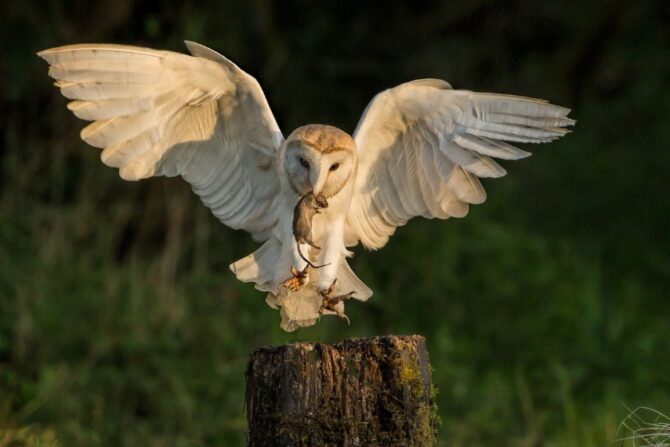
Owls get their food primarily through hunting, again a trait that’s found in birds of prey.
Besides a few species, like the burrowing owl and the snowy owl, this animal is nocturnal and hunts more at night.
Its hunting tools are its eyes, sharp talons, and beaks. Its night vision is like 100 times better than ours, and because they are carnivores, the eyesight is at the front rather than the sides.2
The eyes are immobile, functioning like binoculars.
Their hunting style depends a lot on where they live.
For instance, owls in deserts target their prey while flying, swoop down, and grab either with their talons or beaks.
Some other species give the prey a chase on the ground like land predators do.
When it eventually captures its prey—especially a small one like a mouse—it goes back to its nest to relax and savor its meal.
‘Savoring’ in the owl’s context involves ripping the prey’s flesh apart and piercing through for dinner.
Owls often go for live prey, though a few are known to eat carrion.
How Do Owls Eat?
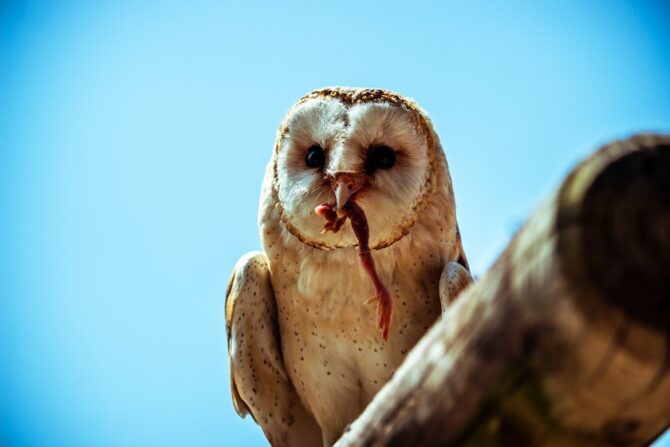
Owls don’t have teeth, and they don’t also chew as some birds can. The only option they have is to swallow the prey, which they can either do whole or in parts.
This is why they take time to rip the prey apart, to make swallowing easier. Some owls pluck off feathers from bird prey, while others swallow it all.
Their digestive system can’t digest bones, feathers, teeth, and fur.
Though the owl swallows all these parts, they eventually regurgitate them.
Ripping the prey apart can help them get the unneeded elements off before swallowing what’s necessary.
When the owl first swallows prey, it first goes through the esophagus before getting to the glandular stomach, where the digestive process begins.
Acids from the glandular stomach break down the meal, effectively replacing the teeth.
The unneeded parts are removed as pellets while the needed elements (fat, meat, organs) move forward in the digestive process.3
Do Owls Have Enemies?
As strong predators, owls have few enemies. They are at the top of the food chain and can withstand attack.
That’s why their eyes are at the front rather than the sides, like herbivorous animals that often fall prey.
However, they aren’t impervious to attack. All birds of prey can become prey themselves, including the owl.
Juveniles are more vulnerable than adults, facing attacks from animals like foxes, wildcats, raccoons, snakes, and skunks.
Other birds of prey, like hawks and eagles, also prey on young owls.
Adult owls hardly get preyed upon except they are sick, old, or injured.
Another predator of owls is their fellow owl, often when resources are scarce in the habitat.
These birds come in different sizes, with the weak preying on the strong.
Humans can also be enemies of owls, though they don’t form a part of our diet.
In the United States, hunting an owl is illegal. In places where there are no restrictions, and they are viewed as ill omen, owls may be unjustly killed.
Owl Species and Their Prey

| Type of Owl | Prey |
|---|---|
| Barn Owl | Birds, fish, rodents, small mammals |
| Snowy Owl | Lemmings, voles, fish |
| Tawny Owl | Insects, mice, voles |
| Barred Owl | Invertebrates, fish, amphibians, reptiles, birds, mice, rabbits |
| Golden masked Owl | Insects, rodents, rabbits, birds |
| Long-eared Owl | Reptiles, small birds, rodents |
| Short-eared Owl | Field voles, birds, small mammals |
| Great Horned Owl | Scorpions, snakes, and other reptiles |
| Eagle Owl | Birds, hares, foxes |
| Little Owl | Invertebrates, birds, mammals |
| Screech Owl | Insects, rodents, slugs, snail |
| Scops Owl | Small insects, vertebrates, and mammals |
| Striped Owl | Insects, small mammals, birds, reptiles |
Related Questions
What do owls mostly eat?
Owls are carnivores, so their diet revolves around the meat that they hunt down.
Prey differs according to the species, but in general, they seem to prefer small mammals like voles and other rodents.
What do owls symbolize?
Owls have both good and bad images, depending on the culture. In many African places, the owl is a symbol of an ill omen.
However, in Ancient Greece and different parts of America, owls are regarded as wise, solemn creatures.
Can owls eat plants?
Owls are carnivores, so eating plants isn’t one of their options. Some species won’t eat plants at all, while a few, like the burrowing owl, can eat fruits if resources are scarce.
Wrap Up
Owls may be enigmatic, but one thing we know is that they are fierce predators that may either hunt at night or during the day, according to the species.
Their preferred meat seems to be rodents and small mammals, but the species adapt to what they can find in their habitat.
References & Notes
- About Owls. Owl Research Institute.
- Owl Eyesight. Buffalo Bill Center of the West.
- Owl Pellet Physiology. Carleton College.
